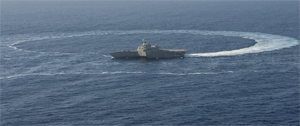The U.S. Defense Department has recommended that the Navy build fewer littoral combat ships (LCS), while a federal audit has questioned their effectiveness and suggested that Congress withhold funding for the program.
Under separate design contracts, Marinette Marine and Austal USA have built four of these vessels intended mainly for near-coast security patrols. Twenty more are on order, with additional contracts expected to be offered over the next several years.
In a Dec. 14 memo, Secretary of Defense Ash Carter told Navy Secretary Ray Mabus that the Navy should cut its planned LCS/frigate procurement from 52 to 40, and should “down select” to one LCS variant by fiscal year 2019.
Four days later, the Government Accountability Office (GAO) recommended that Congress reconsider 2016 funding for the LCS program while the effectiveness of the two vessel designs is evaluated. The GAO said that the LCS’s lethality and survivability are mostly unproven six years after the delivery of two lead ships. Building costs have escalated beyond early estimates.
“The Department of Defense’s Director of Operational Test and Evaluation has stated that there is insufficient data to provide statistical confidence that LCS can meet its lethality requirements in future testing or operations,” the GAO said in December. “The Navy also has not yet demonstrated that LCS will achieve its survivability requirements, and does not plan to complete survivability assessments until 2018 — after more than 24 ships are either in the fleet or under construction.”
Initially, the LCS was to meet the need for shallow-draft coastal vessels to counter threats from mines, quiet submarines and terrorists on small, fast, armed boats. But according to the GAO, the Navy’s requirements for LCS designs were lower than for other surface combatants, and over time the Navy reduced several LCS survivability and lethality demands. The Navy said it would compensate for these adjustments by redefining how the ships would operate.
In 2004, the Navy awarded contracts to two teams that developed the LCS seaframe designs. The Navy has been procuring two variants or models since. One is a steel monohull design with an aluminum superstructure called the Freedom, built by Marinette Marine in Marinette, Wis.; the other is an all-aluminum trimaran design called the Independence, constructed by Austal USA in Mobile, Ala. The Navy has contracted for 24 seaframes, with an equal number of both variants, and has taken delivery of four. Twenty seaframes are currently covered under block-buy contracts, with deliveries to continue until 2020. Under the program, the Navy expects to contract for LCS seaframes in fiscal 2016, 2017 and 2018.
In 2014, the Navy tested an early version of a surface-warfare mission package on the Freedom design to see whether it could meet a lethality demand. The Navy then declared the Freedom operationally effective. But the Navy’s test report showed that the Freedom didn’t meet some key requirements, and the Defense Department said that test data didn’t instill confidence in the Freedom’s lethality capacities.
As for the Independence design, questions about its hull surfaced, and the Navy said it would conduct needed testing in 2015 and 2016. But in December the GAO said the Navy to date lacked significant knowledge about the Independence’s lethality and survivability capabilities. In a trial in rough seas, the Independence sustained damage.
The GAO noted that the Navy had no plans to seek an unbiased outside analysis of the Independence’s rough-water trials. The GAO also said further testing was needed to demonstrate that both LCS models could meet requirements in threat environments. When asked by Professional Mariner about the GAO’s findings, Lockheed Martin, which has teamed with Marinette Marine to build the Freedom class, and Austal USA declined to comment.
The Department of Defense in early 2014 told the Navy to assess options for a small-surface combatant with greater survivability and lethality capabilities than the LCS has. After a study, the Navy recommended adding more of those features to LCS requirements.
Former Defense Secretary Chuck Hagel said in 2014 that he had asked the Navy to submit “alternative proposals to procure a capable and lethal small-surface combatant, generally consistent with the capabilities of a frigate. I’ve directed the Navy to consider a completely new design, existing ship designs and a modified LCS.”
In addition to submitting an acquisition strategy for a modified LCS, the Defense Department told the Navy to assess the costs of backfitting lethality and survivability enhancements on current versions of the LCS.
In December 2015, the GAO suggested that Congress consider restricting funds for three LCS seaframes requested in fiscal year 2016 until the Navy submits an acquisition scheme for a modified LCS approved by the secretary of defense, along with plans to backfit existing ships. Alternatively, the GAO said Congress could decline to fund some, or all, of the Navy’s fiscal 2016 requests for three LCS seaframes, given a lack of knowledge about the ships’ survivability and lethality.
The GAO said the secretary of defense should see that a commitment to buy 20 modified littoral combat ships is affordable compared with other acquisition needs. It said that the Pentagon should ensure that the Navy’s acquisition strategy for modified LCS models doesn’t place industrial-based concerns before lethality, survivability and affordability. GAO also said that the Defense Department must require that the Navy get an assessment from a ship classification society or other group about the survivability of the Independence seaframe.
To ensure that the LCS program has measurable requirements, the GAO said the Defense Department should direct the Navy to conduct onboard LCS mission-package testing in diverse weather and tactical scenarios.

